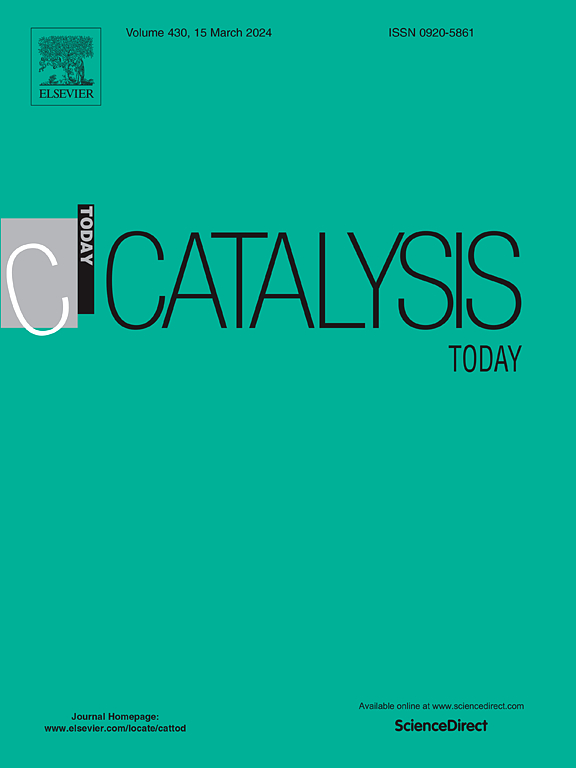ZnO-ZrO2/纳米HZSM-5串联催化剂催化CO2/CO制异烷烃汽油
IF 5.2
2区 化学
Q1 CHEMISTRY, APPLIED
引用次数: 0
摘要
研究了ZnO-ZrO2/纳米级HZSM-5串联催化剂在50 bar、420 ºC条件下直接加氢CO2/CO (COx)混合物制C5+烃(汽油)的性能(转化率、产率和产物选择性)。在串联结构中,酸催化剂和金属催化剂的质量比为1/1,可以有效地最大化甲醇合成和转化阶段之间的协同作用,显著改变甲醇合成的热力学平衡。与催化剂的物理混合相比,单颗粒内的串联催化剂结构(双功能催化剂)面临着挑战,这是扩大规模的兴趣所在。这些包括在球团化过程中催化性能的恶化,部分阻塞沸石微孔和酸位点。然而,双功能催化剂中金属和酸位点之间较短的距离增强了反应阶段之间的协同作用,弥补了这些问题。结果表明,使用双功能催化剂可获得较高的COx和CO2转化率(分别为27.9% %和32.6% %)和较高的汽油收率(21.3% %)。生产的汽油的异烷烃成分(70 %),芳烃含量可以忽略不计,使其适用于要求低环境影响的应用,并有望整合到炼油厂的汽油池中。本文章由计算机程序翻译,如有差异,请以英文原文为准。
Production of isoparaffinic gasoline from CO2/CO over ZnO-ZrO2/nano-sized HZSM-5 tandem catalyst
The performance (conversion, yield, and product selectivity) of ZnO-ZrO2/nano-sized HZSM-5 tandem catalysts in the direct hydrogenation of CO2/CO (COx) mixtures to C5+ hydrocarbons (gasoline) was investigated at 50 bar and 420 ºC. A 1/1 mass ratio between the acid and metallic catalysts in the tandem configuration proved effective for maximizing synergy between the stages of methanol synthesis and its conversion, significantly shifting the thermodynamic equilibrium of methanol synthesis. The tandem catalyst configuration within a single particle (bifunctional catalyst), which is of interest for scale-up, faces challenges compared to physical mixing of the catalysts. These include deterioration of catalytic properties during pelletization, partially blocking the zeolite micropores and acid sites. However, the shorter distance between the metallic and acid sites in the bifunctional catalyst enhances synergy between the reaction stages, compensating for these issues. As a result, with the bifunctional catalyst it is achieved high COx and CO2 conversions (27.9 % and 32.6 %, respectively) and a high gasoline yield (21.3 %). The isoparaffinic composition (70 %) of the produced gasoline, with a negligible aromatic content, makes it suitable for applications requiring low environmental impact and promising for integration into refinery gasoline pools.
求助全文
通过发布文献求助,成功后即可免费获取论文全文。
去求助
来源期刊

Catalysis Today
化学-工程:化工
CiteScore
11.50
自引率
3.80%
发文量
573
审稿时长
2.9 months
期刊介绍:
Catalysis Today focuses on the rapid publication of original invited papers devoted to currently important topics in catalysis and related subjects. The journal only publishes special issues (Proposing a Catalysis Today Special Issue), each of which is supervised by Guest Editors who recruit individual papers and oversee the peer review process. Catalysis Today offers researchers in the field of catalysis in-depth overviews of topical issues.
Both fundamental and applied aspects of catalysis are covered. Subjects such as catalysis of immobilized organometallic and biocatalytic systems are welcome. Subjects related to catalysis such as experimental techniques, adsorption, process technology, synthesis, in situ characterization, computational, theoretical modeling, imaging and others are included if there is a clear relationship to catalysis.
 求助内容:
求助内容: 应助结果提醒方式:
应助结果提醒方式:


